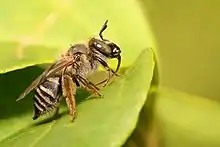| Tetraloniella | |
|---|---|
 | |
| Tetraloniella sp. | |
| Scientific classification | |
| Domain: | Eukaryota |
| Kingdom: | Animalia |
| Phylum: | Arthropoda |
| Class: | Insecta |
| Order: | Hymenoptera |
| Family: | Apidae |
| Subfamily: | Apinae |
| Tribe: | Eucerini |
| Genus: | Tetraloniella Ashmead, 1899 |
| Diversity | |
| at least 100 species | |
Tetraloniella is a genus of long-horned bees in the family Apidae. There are more than 100 described species in Tetraloniella [1][2][3] with most being from North America[4]
Tetraloniella species are solitary and nest in the ground. There have been records of some species that nest in aggregate, with some nests being used over several generations[5]
The dietary preferences of most Tetraloniella species are not known, however there are generalist and specialist species. The specialist species have been noted to be specialists of Asteraceae[5]
See also
References
- ↑ "Tetraloniella Report". Integrated Taxonomic Information System. Retrieved 2019-09-23.
- ↑ "Tetraloniella". GBIF. Retrieved 2019-09-23.
- ↑ "Tetraloniella genus Information". BugGuide.net. Retrieved 2023-04-03.
- ↑ "Factsheet - Tetraloniella bees". keys.lucidcentral.org. Retrieved 2022-01-08.
- 1 2 Wilson, Joseph, Messinger Carril, Olivia (2015). The bees in your backyard: a guide to North America's bees. Princeton, New Jersey, United States: Princeton: Princeton University Press.
{{cite book}}: CS1 maint: multiple names: authors list (link)
Further reading
- Ascher, J.S.; Pickering, J. (2019). "Discover Life bee species guide and world checklist (Hymenoptera: Apoidea: Anthophila)". Retrieved 2019-07-02.
This article is issued from Wikipedia. The text is licensed under Creative Commons - Attribution - Sharealike. Additional terms may apply for the media files.